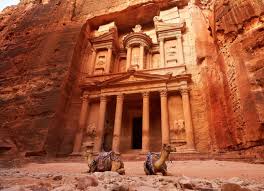Jordanian Arabic is one of the South Levantine Arabic varieties spoken by people who live in Jordan. The Hashemite Kingdom of Jordan through history has been home many civilizations, which have influenced Jordanian Arabic over the centuries. Jordan is divided into twelve governorates (or states) categorized into three main regions; Northern, Central, and Southern.
The Jordanian dialect is divided into five main categories: Urban (also known as Modern or Hybrid Jordanian) spoken by the majority of people in central regions, northern regional dialect, southern regional dialect, Bedawin Arabic, and Aqaba dialect.
Check out our list of Jordanian Arabic Resources.
Differences between Jordanian Arabic and Modern Standard Arabic (MSA)
Jordanian Arabic is different from Modern Standard Arabic (MSA) due to various differences in pronunciation and grammar rules. The grammar rules in Jordanian Arabic are more simplified. Additionally, you will find words from other languages (English and French) used.
Jordanian Arabic is the everyday spoken language used by the local population while MSA is used in written documents like books, newspapers, official documents, and education. You can find a mixture of both Jordanian Arabic and MSA being used for news channels. TV shows are typically in Jordanian Arabic but you can still find shows using MSA only.
Jordanian Dialect in the Central Region
The central region of Jordan includes Amman, Madaba, Zarqa, and Balqa. Amman is Jordan’s capital and the cultural, economic, and political center of the country of more than 4 million people. Jordanian Arabic in Amman is the urban form of south Levantine Arabic in Jordan. People in the central regions pronounce the letter ق as either أ or “g” but not ق. Other letters may also be altered or pronounced the same as the ث ,ذ, and ظ. Also, quite frequently people say the word بِدّي (bidi) which means “I would like.”
Jordanian Dialect in the North Region
The northern part of Jordan includes four main governates: Irbid (the second-largest governate in Jordan), Jerash, Ajloun, and Mafraq. People in the north pronounce the ق as “g” and the ك as “ch/ تْشَ”, while keeping the pronunciation of these letters ث,ذ, and ظ the same. Also instead of using the pronoun أنا which means “I am” people say أَنِي.
Jordanian Dialect in the Southern Region
The southern area of Jordan includes four governates: Karak, Tafilah, and Ma’an. The Jordanian dialect in the south is similar to the Bedouin dialect because the people are geographically close to the Bedouin area. People in the south say “وِدِّي” instead of “بِدِّي”. Additionally, when you want to ask “why” you say “لَوِيه”. While you say “لَوِيشْ” in the North and “لِيشْ” in the central regions.
Aqaba Dialect

The governate of Aquaba in the south is the farthest away from other governates. It has it is own dialect which is a mixture of the spoken dialect in Egypt, Gazza, and Al-Hijaz. Jordanian Arabic found in other areas did not influence the dialect in Aqaba because of the geographic isolation from the other parts of Jordan.
Bedouin Arabic
Nomads living in deserts east of Jordan and in Wadi Rum (southern Jordan) speak Bedouin Arabic. People consider it to be the closest to Modern Standard Arabic (Fusha). Bedouins say “وِدّي” instead of “بِدّي”.
For the present tense “مُضارِعْ” the “أ” does not change to “ب” as the case in of spoken Jordanian Arabic for the other areas in Jordan. For example, the present verb “ألْعَبْ /I play” is pronounced with “أ” by Bedouins while it is pronounced with “ب” as “بَلْعَبْ” by other Jordanians. Also, in the north, central, and south regions the letter “ب” is added before the “ي” in the present tense while it is not the case with Bedouin Arabic. For example, the verb “يَكْتُبْ” he writes” will be “بْيُكْتُبْ” as spoken in the north, south and central regions, while it will be “يَكْتِبْ” by Bedawin people.
How to Learn Jordanian Arabic
If you are interested in learning Jordanian Arabic for work, study, business, or tourism, you need to learn the modern/ hybrid Jordanian dialect that is used by the majority of people. The first step is that you must understand some basic grammar rules of the Arabic language. Typically, MSA grammar resources are ideal for this part of learning Jordanian Arabic.
View Jordanian Arabic resources to help you get started.
Here are some tips and guidelines to help you learn Jordanian Arabic. :
- In Arabic, you place the noun before the adjective. Make a conscious effort to keep this in your mind since it will help you speak better. For example, in Arabic we say “’طفل ذكي” (a kid smart) while in English we say “a smart kid”.
- Keep in mind that there are male and female forms for nouns, adjectives, and verbs in Arabic. Note the difference: We say “هِيَ جَمِيلَة” for a female and “هُوَ جَمِيلْ” for a male.
- Find a language partner if possible and practice speaking as soon as you start learning Arabic. No matter what level are you at or how many mistakes you will make, it is ok. The more you practice, the better you get.
- Watch Jordanian TV shows, listen to the radio, read books, and read articles written in Jordanian Arabic. Developing a familiarity with the language helps you long term, even if you may not understand Arabic at first. Additionally, watching TV shows and news helps you understand more about the culture.
